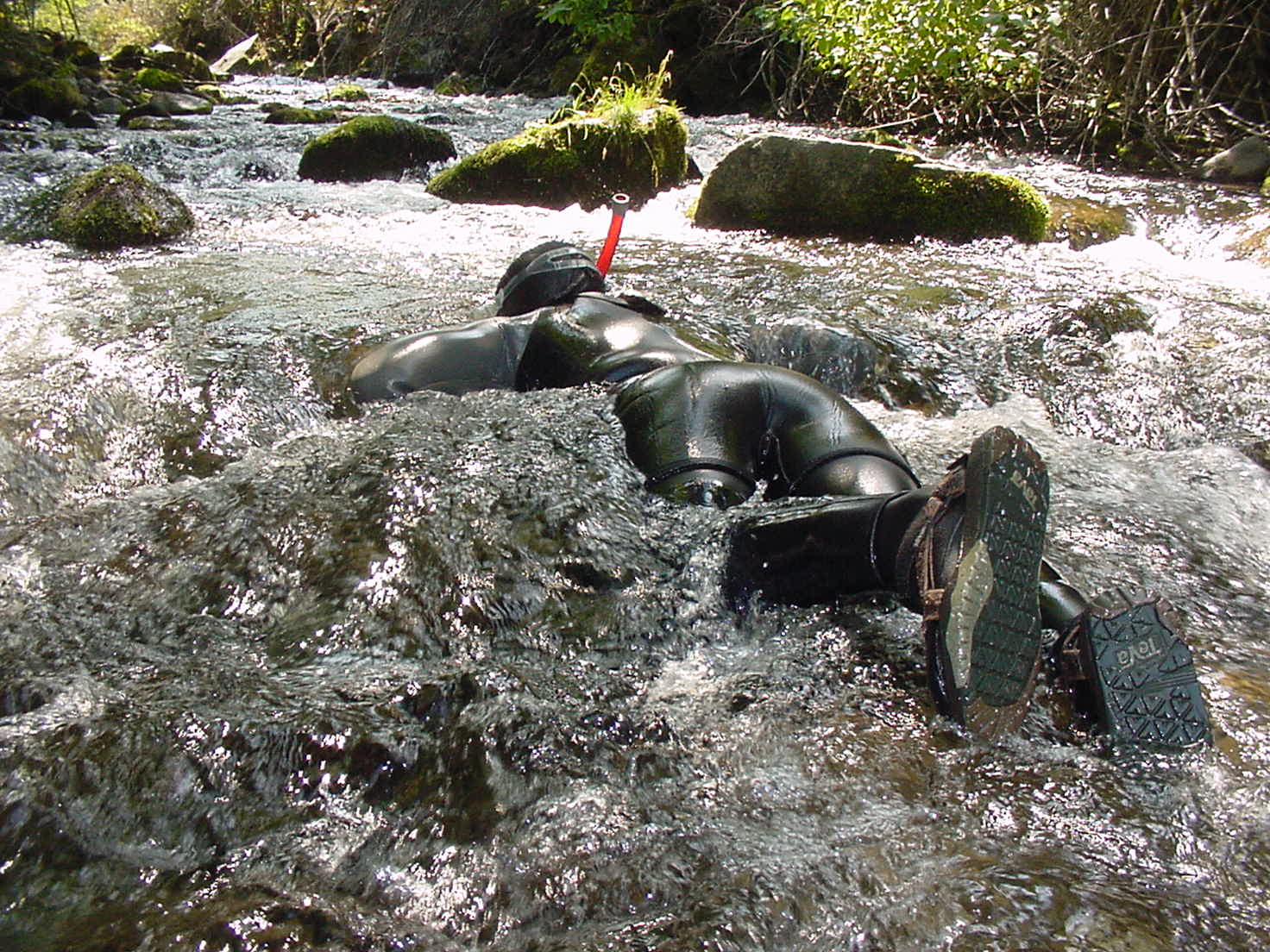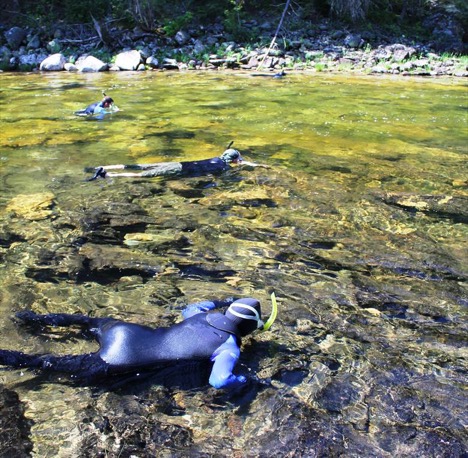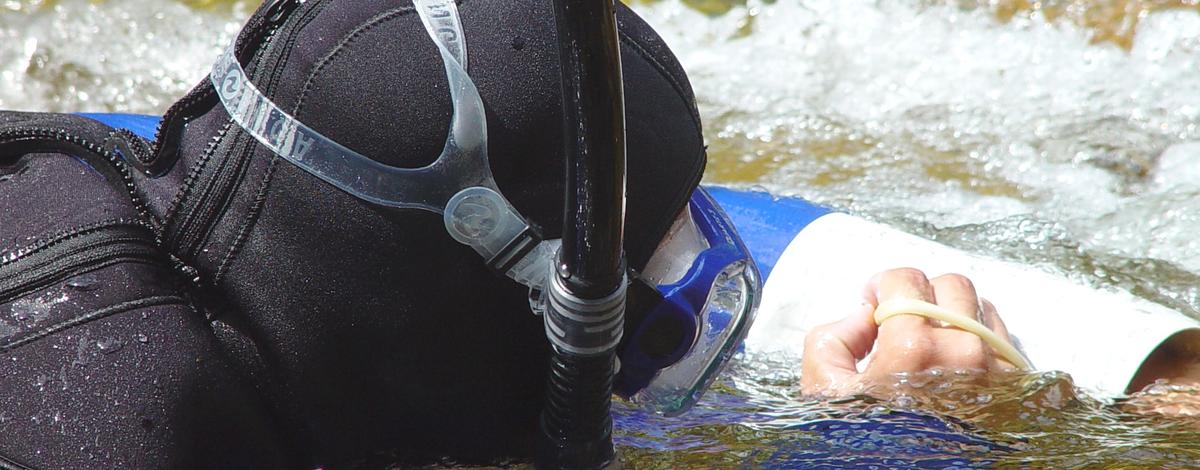
Braving chilly mornings and even colder water, crews of young men and women of the Idaho Department of Fish and Game stretch into tight neoprene wetsuits each summer to snorkel streams and rivers of the state.
Their goal is to gather information about the distribution, abundance, and age of various fish species in Idaho’s waters so data can be analyzed and Fish and Game can better manage fisheries.
“But it’s not just grab your snorkel and jump in the stream,” says Scott Putnam, Fish and Game fisheries biologist who leads training snorkel crews each summer. “A crew’s season begins in the classroom, then the swimming pool.”
Classroom training involves each snorkeler learning to identify a variety of fish species they are likely to encounter. They frequently see Chinook salmon, steelhead, several trout species and whitefish, along with non-game fish such as speckled and longnose dace, redside shiner, bridgelip sucker, northern pikeminnow, and largescale sucker, as well as freshwater mussels and amphibians.
“Identifying adult fish species from one another is one thing, but telling the difference between the little guys can be tricky,” Putnam says. “Knowing what to look for is critical.”
Fish and Game’s snorkel training continues to grow each year, with approximately 40 participants from across the state attending this spring’s training. Besides Fish and Game employees, personnel from the U.S. Forest Service, other management agencies and universities are also trained, and survey procedures are standardized among the various crews.
After fish identification basics are covered, each student is outfitted with the necessary equipment - snorkel, mask, boots, gloves, and wetsuit - all necessities to stay submersed in Idaho’s frigid mountain waters for several hours per day.
“Your gear is critical, especially when you’re in water as cold as 42 degrees,” Putnam said. “To be efficient at gathering information, all equipment needs to fit and be in top condition.”
Then it’s off to the city swimming pool where each snorkeler must correctly identify the different species underwater and estimate their size by using laminated fish photographs attached to a weighted rod appropriately known as ‘“fish sticks.”

“It sounds unusual, but using ‘fish sticks’ is actually very effective for training and the closest we could think of to mimic the real thing,” says Putnam. “But estimating the size of fish underwater can be challenging because of distortion and not having a reference to compare things to. Accuracy comes with time and practice.”
After everyone is proficient in the pool, the actual stream training takes place. Beginning snorkelers are paired alongside experienced crew members, and each crawl slowly upstream, side-by-side, observing and counting what they see. Each fish’s size and species is documented by penciling a mark on a large-diameter PVC pipe, called a “cuff”, worn around the snorkeler’s lower arm. Crews are also currently testing the practicality of using electronic tablets to record data as part of a pilot study.

“Even with numb lips and faces, you’ll get pretty good at understanding each other’s slurred words by the end of summer,” he says with a chuckle. “Each crew also develops their own unique sign language to relay information.”
After the end of each training survey, numbers are tallied and compared. Over the next few days of training, when the crew works as a team and can accurately identify fish species and their size in the natural environment, the strenuous summer work begins.
“Hiking up to 12 miles each day is one thing, but then try belly crawling over boulders against the current a couple hundred yards” said Putnam. “It’s amazing work though, and you’ll be in the best shape of your life by August.”
Each snorkel survey site, called a transect, is generally between 50 to 200 yards. Smaller streams can be surveyed by an individual, or in pairs. On large streams, the snorkelers space out evenly from shore to shore and work slowly upstream. Each snorkeler is responsible for counting fish in their area, while also trying to remain in line with the next person.

With easy access to the streams, six to eight transects can be surveyed in a day. Many of Idaho’s streams are snorkeled to check on the status of juvenile wild chinook and steelhead, which are listed under the federal Endangered Species Act.
Remote sites typically involve a day or two of hiking and an overnight stay along the stream. Crews also use backpacks, horses, planes, jet boats and rafts to access their snorkel sites.
“Snorkeling in much of Idaho overshadows any discomfort associated with getting there,” says Putnam. “It’s a wonderful way to spend the summer.”
Crews generally begin in lower elevation areas after spring runoff and work their way up river systems as the summer progresses. By the end of summer, crews will survey several hundred sites across the state.
Because some crews work mostly in remote, backcountry portions of the state, they are also trained in wilderness first-aid and swift-water rescue. Lewiston-area crews survey streams throughout the Clearwater Region, while similar crews from Salmon, McCall, and Nampa work in other portions of the state.
The information gathered each year is used to track long-term trends in fish abundance. These trends help fisheries managers determine increases or declines in fish populations and prioritize management efforts, such as modifying fishing regulations or initiating habitat-improvement projects.
When combined with other studies, snorkel information guides recommendations for management, and it can also gauge the results of previous management changes.

